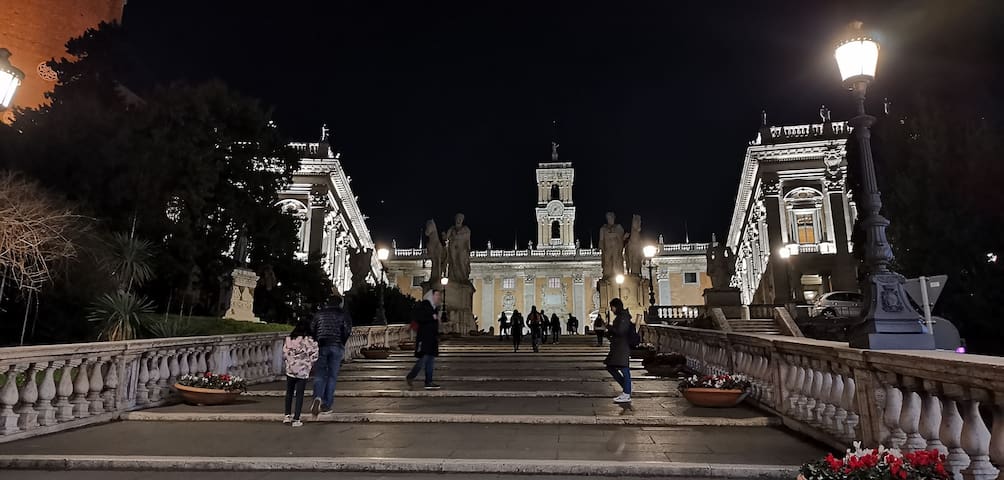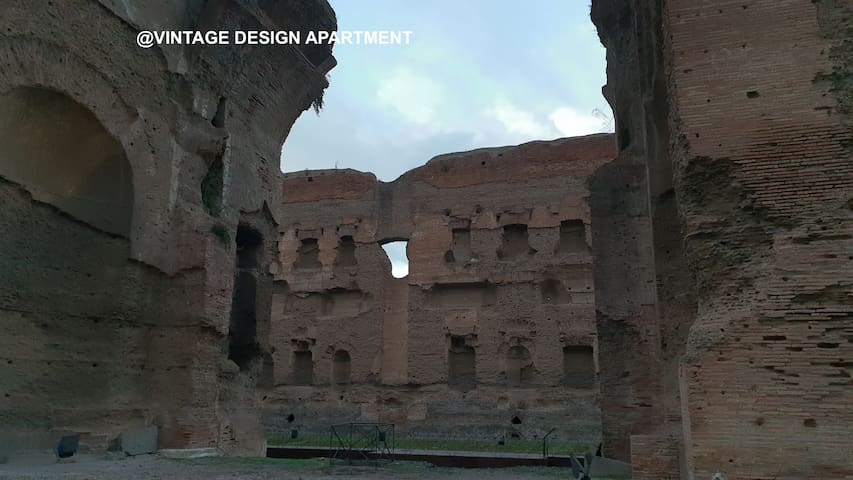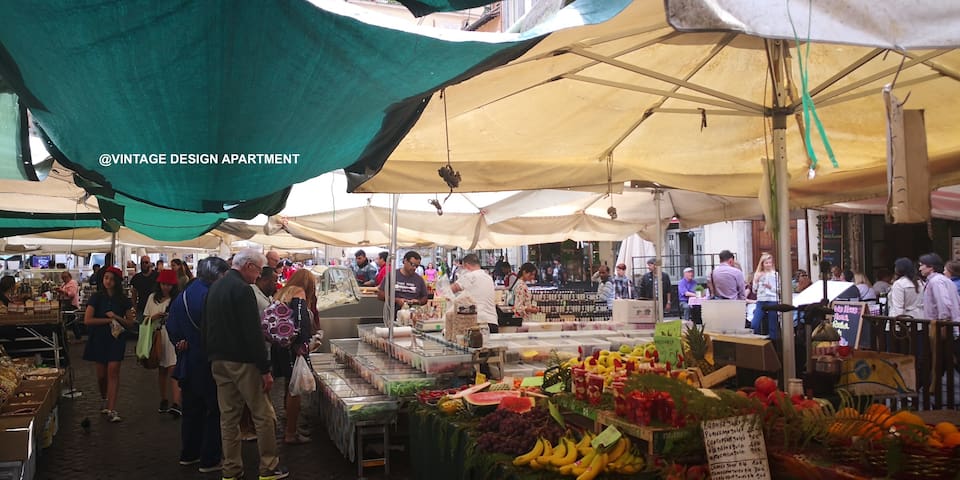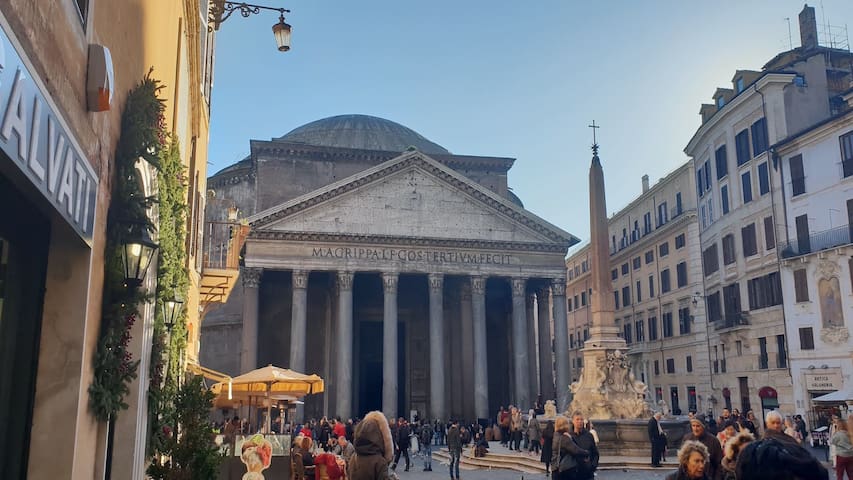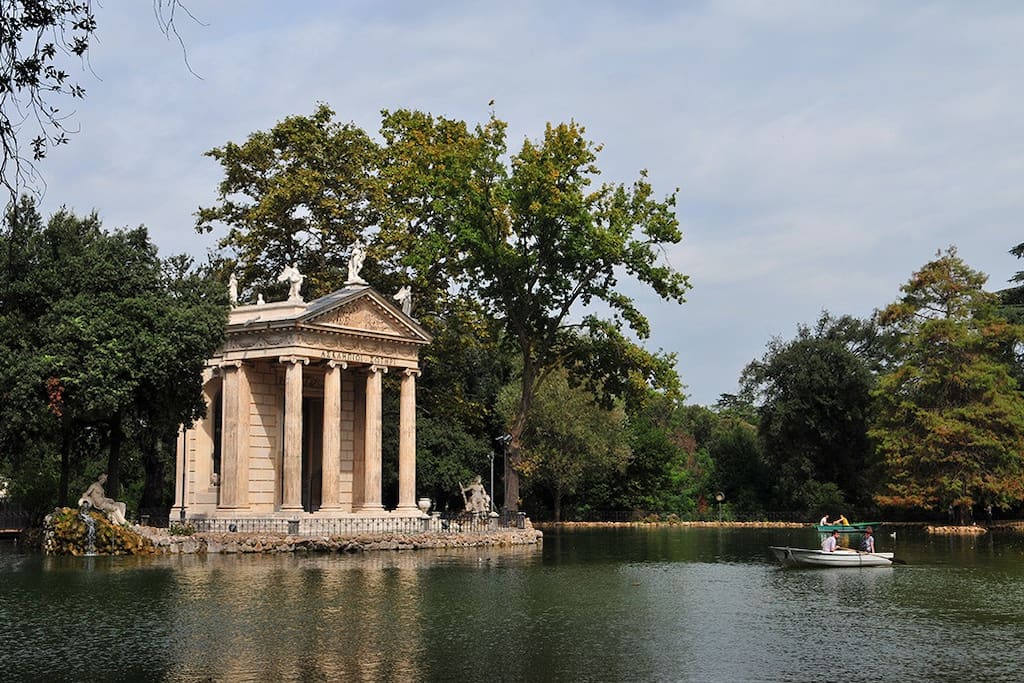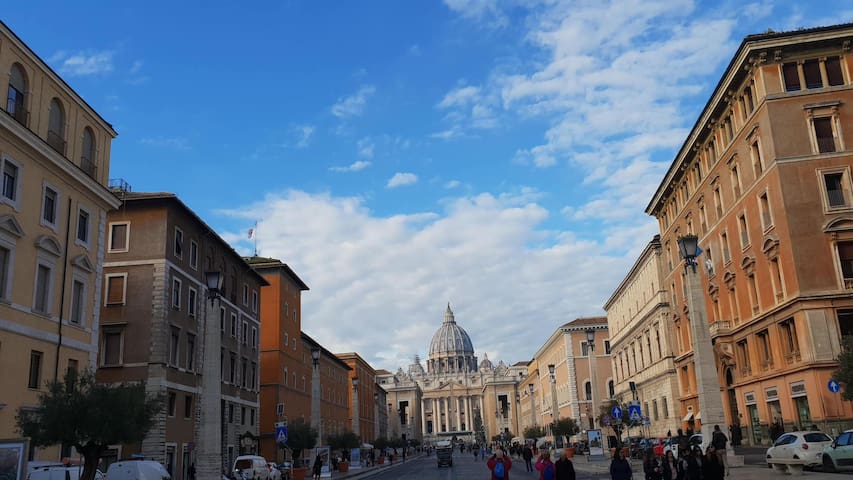PIAZZA VENEZIA
Non fuit in solo Roma peracta die
(Rome was not build in a day)
Take time to visit Rome, here some proposal for your “Roman Walk”.
Piazza Venezia
20 minutes walk from the apartment or tram #8 from Viale Trastevere)
1. Musei capitolini
2. Piazza del Campidoglio
3. Altare della Patria (Vittoriano)
4. Terrazza panoramica Vittoriano
576 locals recommend
Piazza Venezia
Non fuit in solo Roma peracta die
(Rome was not build in a day)
Take time to visit Rome, here some proposal for your “Roman Walk”.
Piazza Venezia
20 minutes walk from the apartment or tram #8 from Viale Trastevere)
1. Musei capitolini
2. Piazza del Campidoglio
3. Altare della Patria (Vittoriano)
4. Terrazza panoramica Vittoriano
The oldest public museum in the world, founded in 1471 by Sixtus IV with the donation to the Roman people of the great Lateran bronzes, is divided into two buildings that together with the Senate Palace delimit the Piazza del Campidoglio, the Palazzo dei Conservatori and the Palazzo Nuovo.
http://www.museicapitolini.org/en/informazioni_pratiche/biglietti_e_videoguide
427 locals recommend
Capitoline Wolf
1 Piazza del CampidoglioThe oldest public museum in the world, founded in 1471 by Sixtus IV with the donation to the Roman people of the great Lateran bronzes, is divided into two buildings that together with the Senate Palace delimit the Piazza del Campidoglio, the Palazzo dei Conservatori and the Palazzo Nuovo.
http://www.museicapitolini.org/en/informazioni_pratiche/biglietti_e_videoguide
The first square that modern Rome has seen born according to the criteria of a uniform project, due to the genius of Michelangelo, stands on the Capitoline hill (Capitolium), where there was an ancient village and place chosen to dedicate many temples to the Roman gods.
185 locals recommend
Campidoglio
Piazza del CampidoglioThe first square that modern Rome has seen born according to the criteria of a uniform project, due to the genius of Michelangelo, stands on the Capitoline hill (Capitolium), where there was an ancient village and place chosen to dedicate many temples to the Roman gods.
The Vittoriano stands in the center of the capital of Italy, tall and majestic. Climbing the large steps and reaching thanks to the panoramic elevators the spectacular terrace at the top, walking through its monumental spaces, stopping and reflecting on the memories of the nation means entering the heart of Italy. Yesterday’s Italy, daughter of the long and troubled Risorgimento process, and today’s Italy, anti-fascist, democratic and European
http://www.ilvittoriano.com/index-en.html
337 locals recommend
Altar of the Fatherland
Piazza VeneziaThe Vittoriano stands in the center of the capital of Italy, tall and majestic. Climbing the large steps and reaching thanks to the panoramic elevators the spectacular terrace at the top, walking through its monumental spaces, stopping and reflecting on the memories of the nation means entering the heart of Italy. Yesterday’s Italy, daughter of the long and troubled Risorgimento process, and today’s Italy, anti-fascist, democratic and European
http://www.ilvittoriano.com/index-en.html
VIA FORI IMPERIALI
Non fuit in solo Roma peracta die
(Rome was not build in a day)
Take time to visit Rome, here some proposal for your “Roman Walk”.
The Ancient Rome: Via dei Fori Imperiali
20 minutes walk from the apartment or tram #8 from Viale Trastevere
1. Fori Imperiali
2. Colosseo
3. Arco di Costantino
4. Palatino
5. Circo Massimo
6. Bocca della Verità
7. Terme Caracalla
147 locals recommend
Via dei Fori Imperiali
Via dei Fori ImperialiNon fuit in solo Roma peracta die
(Rome was not build in a day)
Take time to visit Rome, here some proposal for your “Roman Walk”.
The Ancient Rome: Via dei Fori Imperiali
20 minutes walk from the apartment or tram #8 from Viale Trastevere
1. Fori Imperiali
2. Colosseo
3. Arco di Costantino
4. Palatino
5. Circo Massimo
6. Bocca della Verità
7. Terme Caracalla
The Colosseum, which is still the largest amphitheater in the world today, was commissioned by Emperor Titus Flavius Vespasian who chose the area between the Palatine, Esquiline and Celio hills to build it, previously occupied by the artificial lake of Nero's Domus Aurea. Its construction began in 70 AD. and ended in 80 A.D. under the empire of Titus, son of Vespasian.
2612 locals recommend
Colosseum
1 Piazza del ColosseoThe Colosseum, which is still the largest amphitheater in the world today, was commissioned by Emperor Titus Flavius Vespasian who chose the area between the Palatine, Esquiline and Celio hills to build it, previously occupied by the artificial lake of Nero's Domus Aurea. Its construction began in 70 AD. and ended in 80 A.D. under the empire of Titus, son of Vespasian.
The Arch of Constantine, located along the route traveled by the triumphs, in the stretch between the Circus Maximus and the Arch of Titus, is the largest honorary arch that has come down to us and represents a synthesis of the ideological propaganda of the Constantinian era. The arch in fact celebrates the triumph of Emperor Constantine over Maxentius, which took place on 28 October 312 AD. following the battle of Ponte Milvio. The inscription on the central arch tells that the monument was solemnly dedicated by the Senate to the emperor in memory of that triumph and on the occasion of the decade of the empire at the beginning of the tenth year of reign, on 25 July 315 AD.
57 locals recommend
Arch of Constantine
Via di San GregorioThe Arch of Constantine, located along the route traveled by the triumphs, in the stretch between the Circus Maximus and the Arch of Titus, is the largest honorary arch that has come down to us and represents a synthesis of the ideological propaganda of the Constantinian era. The arch in fact celebrates the triumph of Emperor Constantine over Maxentius, which took place on 28 October 312 AD. following the battle of Ponte Milvio. The inscription on the central arch tells that the monument was solemnly dedicated by the Senate to the emperor in memory of that triumph and on the occasion of the decade of the empire at the beginning of the tenth year of reign, on 25 July 315 AD.
At 40 meters above the Roman Forum, the Palatine Hill is the most central of the seven hills of Rome and is also one of the oldest areas of the city.
Mount Palatine is the cradle of the capital and it is assumed that the area was inhabited since 1000 BC. During the Republican period, the citizens of Roman high society settled on the Palatine Hill and built sumptuous palaces, of which numerous archaeological remains are currently preserved.
186 locals recommend
Palatine Hill
Via SacraAt 40 meters above the Roman Forum, the Palatine Hill is the most central of the seven hills of Rome and is also one of the oldest areas of the city.
Mount Palatine is the cradle of the capital and it is assumed that the area was inhabited since 1000 BC. During the Republican period, the citizens of Roman high society settled on the Palatine Hill and built sumptuous palaces, of which numerous archaeological remains are currently preserved.
The Circus Maximus is an ancient Roman circus located in Rome. Located in the valley between the Palatine and the Aventine, it is remembered as a venue for games since the beginning of the history of the city:
301 locals recommend
Circus Maximus
Via del Circo MassimoThe Circus Maximus is an ancient Roman circus located in Rome. Located in the valley between the Palatine and the Aventine, it is remembered as a venue for games since the beginning of the history of the city:
The Bocca della Verità is an ancient mask in pavonazzetto marble, walled into the wall of the pronaos of the church of Santa Maria in Cosmedin in Rome since 1632. The mask represents a bearded male face; eyes, nose and mouth are pierced and hollow. The face has been interpreted over time as a representation of various subjects: Jupiter Ammon, the ocean god, an oracle or a faun.
248 locals recommend
Mouth of Truth
18 Piazza della Bocca della VeritàThe Bocca della Verità is an ancient mask in pavonazzetto marble, walled into the wall of the pronaos of the church of Santa Maria in Cosmedin in Rome since 1632. The mask represents a bearded male face; eyes, nose and mouth are pierced and hollow. The face has been interpreted over time as a representation of various subjects: Jupiter Ammon, the ocean god, an oracle or a faun.
The Baths of Caracalla are the greatest example of large imperial baths and one of the largest thermal complexes of antiquity.
Powerful walls, perfect state of conservation and new virtual technologies are the perfect mix that will make you fall in love with it.
397 locals recommend
Baths of Caracalla
Viale delle Terme di CaracallaThe Baths of Caracalla are the greatest example of large imperial baths and one of the largest thermal complexes of antiquity.
Powerful walls, perfect state of conservation and new virtual technologies are the perfect mix that will make you fall in love with it.
The Basilica of San Clemente in Laterano, located about 300 meters beyond the Colosseum, on the road that from the valley between the Oppian hill and the Celio leads to San Giovanni in Laterano, is one of the most interesting and ancient basilicas of Rome, erected before 385 and dedicated to Saint Clemente, the third pope after Saint Peter. It consists of two overlapping churches, built on Roman buildings of the Republican age and on the remains of a temple of the god Mithra.
Basilica of San Clemente
The Basilica of San Clemente in Laterano, located about 300 meters beyond the Colosseum, on the road that from the valley between the Oppian hill and the Celio leads to San Giovanni in Laterano, is one of the most interesting and ancient basilicas of Rome, erected before 385 and dedicated to Saint Clemente, the third pope after Saint Peter. It consists of two overlapping churches, built on Roman buildings of the Republican age and on the remains of a temple of the god Mithra.
"CORE DE ROMA" (Heart of Rome)
Non fuit in solo Roma peracta die
(Rome was not build in a day)
Take time to visit Rome, here some proposal for your “Roman Walk”.
A walk in the center of Rome
Walk by Viale Trastevere to Tiberina Island (10 min walk from the apartment)
1. Tiberina Island
2. Sinagoga and Ebraic Ghetto
3. Campo de Fiori square
4. Navona square
5. Pantheon
6. Trevi Fountain
7. Piazza di Spagna
8. Trinità dei Monti
9. Terrazza del Pincio (amazing view of Rome)
10. Villa Borghese park
11. Galleria Borghese (reservation and tickets: https://galleriaborghese.beniculturali.it/en/visita/info-biglietti/)
1461 locals recommend
Trevi Fountain
Piazza di TreviNon fuit in solo Roma peracta die
(Rome was not build in a day)
Take time to visit Rome, here some proposal for your “Roman Walk”.
A walk in the center of Rome
Walk by Viale Trastevere to Tiberina Island (10 min walk from the apartment)
1. Tiberina Island
2. Sinagoga and Ebraic Ghetto
3. Campo de Fiori square
4. Navona square
5. Pantheon
6. Trevi Fountain
7. Piazza di Spagna
8. Trinità dei Monti
9. Terrazza del Pincio (amazing view of Rome)
10. Villa Borghese park
11. Galleria Borghese (reservation and tickets: https://galleriaborghese.beniculturali.it/en/visita/info-biglietti/)
Here, connected to the city by two ancient Roman bridges, rises Tiber Island, a boat shaped island, once called Insula Inter Duos Pontes, in Latin, which means “Island Between Two Bridges”. The island has a characteristic boat shape, it’s 270 meters long and 67 meters wide.
267 locals recommend
Tiber Island
Here, connected to the city by two ancient Roman bridges, rises Tiber Island, a boat shaped island, once called Insula Inter Duos Pontes, in Latin, which means “Island Between Two Bridges”. The island has a characteristic boat shape, it’s 270 meters long and 67 meters wide.
The Temple Major is the main synagogue of Rome. It was built between 1901 and 1904.
For the Roman Jews, the Tempio Maggiore represents, in addition to a place of prayer, a fundamental cultural landmark and houses the Jewish museum of Rome.
69 locals recommend
Great Synagogue of Rome
Lungotevere de' CenciThe Temple Major is the main synagogue of Rome. It was built between 1901 and 1904.
For the Roman Jews, the Tempio Maggiore represents, in addition to a place of prayer, a fundamental cultural landmark and houses the Jewish museum of Rome.
Campo de' Fiori is one of the most particular and loved areas of the capital. It is the ideal context for a pleasant walk among its historic wooden stalls where you can buy flowers, fruit, always fresh meat and fish;At dusk, the square comes alive with a convivial and lively atmosphere and transforms into the perfect place to meet for a classic aperitif in the trendy lounge bars that surround it or for a hearty dinner in one of its characteristic outdoor restaurants. open, to then immerse yourself in the electrifying Roman nightlife.
787 locals recommend
Campo de' Fiori
Campo de' FioriCampo de' Fiori is one of the most particular and loved areas of the capital. It is the ideal context for a pleasant walk among its historic wooden stalls where you can buy flowers, fruit, always fresh meat and fish;At dusk, the square comes alive with a convivial and lively atmosphere and transforms into the perfect place to meet for a classic aperitif in the trendy lounge bars that surround it or for a hearty dinner in one of its characteristic outdoor restaurants. open, to then immerse yourself in the electrifying Roman nightlife.
Navona Square is one of the most spectacular and characteristic squares of Baroque Rome, built on the remains of the Stadium of Domitian. The shape of the current square reproduces precisely the perimeter of the ancient stadium that the emperor built in 86 AD for athletics competitions and horse racing.
1722 locals recommend
Piazza Navona
Piazza NavonaNavona Square is one of the most spectacular and characteristic squares of Baroque Rome, built on the remains of the Stadium of Domitian. The shape of the current square reproduces precisely the perimeter of the ancient stadium that the emperor built in 86 AD for athletics competitions and horse racing.
“The most beautiful relic of ancient Rome, a temple so well preserved that it appears as the Romans must have seen it in their times,” so described it the French writer Stendhal in the 19th century. A source of inspiration for the greatest architects of all ages, its beauty, the harmony of the lines and the perfect geometries have always struck people both in the past and the present.
1342 locals recommend
Pantheon
Piazza della Rotonda“The most beautiful relic of ancient Rome, a temple so well preserved that it appears as the Romans must have seen it in their times,” so described it the French writer Stendhal in the 19th century. A source of inspiration for the greatest architects of all ages, its beauty, the harmony of the lines and the perfect geometries have always struck people both in the past and the present.
The Spanish Steps are an extraordinary masterpiece of 18th-century scenographic taste. They represent the ideal link between the Pincio hill and the underlying Piazza di Spagna, formerly separated by a bare, steep, and muddy hill.
77 locals recommend
Trinita dei Monti
3 Piazza della Trinità dei MontiThe Spanish Steps are an extraordinary masterpiece of 18th-century scenographic taste. They represent the ideal link between the Pincio hill and the underlying Piazza di Spagna, formerly separated by a bare, steep, and muddy hill.
In the afternoon towards sunset, Rome has an unforgettable appearance, particularly from the Terrace of the Pincio, a grandiose public park created by Giuseppe Valadier (1834) and urban walk citizens love. Below the Terrace, is the spacious Piazza del Popolo, looking like an imposing and lively theater. Beyond the balustrade, the city stretches: the majestic dome of San Pietro dominates the horizon, Monte Mario is on the right, the Quirinale Hill is on the left. In the distance, high on the Janiculum hill, you can guess the equestrian monument of Giuseppe Garibaldi. In the middle, architecturally well defined, the ancient 16th-century buildings stand out.
88 locals recommend
Terrace of the Pincio
Viale Gabriele D'AnnunzioIn the afternoon towards sunset, Rome has an unforgettable appearance, particularly from the Terrace of the Pincio, a grandiose public park created by Giuseppe Valadier (1834) and urban walk citizens love. Below the Terrace, is the spacious Piazza del Popolo, looking like an imposing and lively theater. Beyond the balustrade, the city stretches: the majestic dome of San Pietro dominates the horizon, Monte Mario is on the right, the Quirinale Hill is on the left. In the distance, high on the Janiculum hill, you can guess the equestrian monument of Giuseppe Garibaldi. In the middle, architecturally well defined, the ancient 16th-century buildings stand out.
The park of Villa Borghese occupies a vast area in the heart of the city. The villa contains buildings, sculptures, monuments and fountains, the work of illustrious artists of the Baroque, Neoclassical and Eclectic art, surrounded by ancient trees, ponds, Italian gardens and large open spaces, created with great care.
2099 locals recommend
Villa Borghese
Piazzale Napoleone IThe park of Villa Borghese occupies a vast area in the heart of the city. The villa contains buildings, sculptures, monuments and fountains, the work of illustrious artists of the Baroque, Neoclassical and Eclectic art, surrounded by ancient trees, ponds, Italian gardens and large open spaces, created with great care.
Located within the homonymous Villa, the Borghese Gallery houses a remarkable collectionpainting of sculptures, bass-reliefs, ancient mosaics, sixteenth-seventeenth century paintings, and sculptures. It includes masterpieces by Antonello da Messina, Giovanni Bellini, Perugino, Pinturicchio, Veronese, Raffaello, (Deposition), Domenichino (Diana’s hunt), Tiziano, (Sacred and profane love, Venus blindfolding Love), Correggio (Danae), and Caravaggio (Youth with a fruit basket, the Madonna of the footmen, David with Goliath’s head), Rubens (Pietà), as well as wonderful sculptures by Gian Lorenzo Bernini (Apollo and Daphne, the Rape of Proserpina, David) and Canova (Paolina Borghese).
681 locals recommend
Borghese Gallery and Museum
5 Piazzale Scipione BorgheseLocated within the homonymous Villa, the Borghese Gallery houses a remarkable collectionpainting of sculptures, bass-reliefs, ancient mosaics, sixteenth-seventeenth century paintings, and sculptures. It includes masterpieces by Antonello da Messina, Giovanni Bellini, Perugino, Pinturicchio, Veronese, Raffaello, (Deposition), Domenichino (Diana’s hunt), Tiziano, (Sacred and profane love, Venus blindfolding Love), Correggio (Danae), and Caravaggio (Youth with a fruit basket, the Madonna of the footmen, David with Goliath’s head), Rubens (Pietà), as well as wonderful sculptures by Gian Lorenzo Bernini (Apollo and Daphne, the Rape of Proserpina, David) and Canova (Paolina Borghese).
Spanish Steps
Piazza di SpagnaSpanish steps.
VATICANO
Non fuit in solo Roma peracta die
(Rome was not build in a day)
Take time to visit Rome, here some proposal for your “Roman Walk”.
Vaticano
Tram #8 to lungotevere De Cenci + Bus 28 to Via Della Conciliazione
1. Via della Conciliazione
2. St. Peter Square
3. St. Peter Basilica
4. Vatican Museum
https://tickets.museivaticani.va/home
5. Castel Sant'Angelo
(Very close of St. Peter square)
https://www.tosc.it/en/artist/museo-nazionale-castel-sant-angelo/
563 locals recommend
Vatican City
Non fuit in solo Roma peracta die
(Rome was not build in a day)
Take time to visit Rome, here some proposal for your “Roman Walk”.
Vaticano
Tram #8 to lungotevere De Cenci + Bus 28 to Via Della Conciliazione
1. Via della Conciliazione
2. St. Peter Square
3. St. Peter Basilica
4. Vatican Museum
https://tickets.museivaticani.va/home
5. Castel Sant'Angelo
(Very close of St. Peter square)
https://www.tosc.it/en/artist/museo-nazionale-castel-sant-angelo/
The original Saint Peter’s Basilica, a building of a dimension comparable to the current one, was erected around 320 by the emperor Constantine in the place where, according to tradition, the apostle Peter was buried.
From the mid-fifteenth century began that long process which, in about two hundred years and with the help of many artists (Bramante, Michelangelo, Bernini), led to the complete reconstruction of the primitive Constantinian basilica.
Even the current Piazza San Pietro with its splendid colonnade had a completely different form: today’s appearance is a true masterpiece by Gian Lorenzo Bernini.
850 locals recommend
St. Peter's Basilica
Piazza San PietroThe original Saint Peter’s Basilica, a building of a dimension comparable to the current one, was erected around 320 by the emperor Constantine in the place where, according to tradition, the apostle Peter was buried.
From the mid-fifteenth century began that long process which, in about two hundred years and with the help of many artists (Bramante, Michelangelo, Bernini), led to the complete reconstruction of the primitive Constantinian basilica.
Even the current Piazza San Pietro with its splendid colonnade had a completely different form: today’s appearance is a true masterpiece by Gian Lorenzo Bernini.
The Vatican Museums are the national museum of the Vatican City, in Rome.[1] Founded by Pope Julius II in the 16th century[2], they occupy a large part of the vast courtyard of the Belvedere and are one of the largest art collections in the world, since they exhibit the enormous collection of works of art accumulated over the centuries by popes: the Sistine Chapel and the papal apartments frescoed by Michelangelo and Raphael are part of the works that visitors can admire on their journey. Although the museums are located entirely in Vatican territory, their entrance is in Italian territory, in viale Vaticano 6 in Rome.
1756 locals recommend
Vatican Museums
The Vatican Museums are the national museum of the Vatican City, in Rome.[1] Founded by Pope Julius II in the 16th century[2], they occupy a large part of the vast courtyard of the Belvedere and are one of the largest art collections in the world, since they exhibit the enormous collection of works of art accumulated over the centuries by popes: the Sistine Chapel and the papal apartments frescoed by Michelangelo and Raphael are part of the works that visitors can admire on their journey. Although the museums are located entirely in Vatican territory, their entrance is in Italian territory, in viale Vaticano 6 in Rome.
TRASTEVERE
This ancient square at the center of Rione Trastevere is dominated by the Basilica of Santa Maria Maggiore from which it takes its name. Considered the oldest in Rome, the Basilica was built in the same place where a fountain was at the time of Emperor Augustus.
384 locals recommend
Basilica of Our Lady in Trastevere
Piazza di Santa Maria in TrastevereThis ancient square at the center of Rione Trastevere is dominated by the Basilica of Santa Maria Maggiore from which it takes its name. Considered the oldest in Rome, the Basilica was built in the same place where a fountain was at the time of Emperor Augustus.
Built by Pope Sisto IV della Rovere (1471-1484) for the Jubilee of 1475, the suggestive and romantic Ponte Sisto has a postcard background from which you can see the dome of St. Peter. It allowed direct communication to Piazza Trilussa in the Rione XIII - Trastevere, and the Vatican, with the rest of the city.
66 locals recommend
Ponte Sisto
Piazza TrilussaBuilt by Pope Sisto IV della Rovere (1471-1484) for the Jubilee of 1475, the suggestive and romantic Ponte Sisto has a postcard background from which you can see the dome of St. Peter. It allowed direct communication to Piazza Trilussa in the Rione XIII - Trastevere, and the Vatican, with the rest of the city.
It is one of the most popular meeting places for young Romans and tourists, thanks to its clubs and welcoming atmosphere: located in the heart of Trastevere district, in front of Ponte Sisto, between Lungotevere della Farnesina and Lungotevere Raffaello Sanzio, this charming square is dedicated to the great Roman satirical poet Carlo Alberto Salustri, better known as Trilussa.
Here is located the beautiful fountain of Acqua Paola by the architects Van Santen, known as Vasanzio, and Giovanni Fontana. It was commissioned by Pope Paul V Borghese (1605-1620) in 1613, to feed the districts of Trastevere, Borgo, Regola, and Ponte. Conceived as a monumental arch with a central niche flanked by two Ionic columns, the fountain has a high attic holding the Borghese family coat of arms, with eagle and dragon, and a celebratory inscription dedicated to the pontiff, for having led the water on the left bank of the Tiber. Initially, it was located at the end of Via Giulia, close to the Hospice of Mendicants built by Pope Sixtus V Peretti (1585-1590). It took its water from the Traiano-Paolo aqueduct.
280 locals recommend
Piazza Trilussa
42 Piazza TrilussaIt is one of the most popular meeting places for young Romans and tourists, thanks to its clubs and welcoming atmosphere: located in the heart of Trastevere district, in front of Ponte Sisto, between Lungotevere della Farnesina and Lungotevere Raffaello Sanzio, this charming square is dedicated to the great Roman satirical poet Carlo Alberto Salustri, better known as Trilussa.
Here is located the beautiful fountain of Acqua Paola by the architects Van Santen, known as Vasanzio, and Giovanni Fontana. It was commissioned by Pope Paul V Borghese (1605-1620) in 1613, to feed the districts of Trastevere, Borgo, Regola, and Ponte. Conceived as a monumental arch with a central niche flanked by two Ionic columns, the fountain has a high attic holding the Borghese family coat of arms, with eagle and dragon, and a celebratory inscription dedicated to the pontiff, for having led the water on the left bank of the Tiber. Initially, it was located at the end of Via Giulia, close to the Hospice of Mendicants built by Pope Sixtus V Peretti (1585-1590). It took its water from the Traiano-Paolo aqueduct.
In the heart of Rome between Via della Lungara and the Gianicolo Hill, you can find a magical place where to walk away from the chaos of the city, and enjoy the spectacle represented by the extraordinary variety of the plant world preserved here.
Among the largest in Italy, the Botanical Garden of Rome is located in the park of Villa Corsini, once the residence of Christine of Sweden, and on part of the Horti Getae, archaeological area formerly constituted by the Baths of Septimius Severus.
278 locals recommend
Botanical Garden of Rome
23 A - 24 Largo Cristina di SveziaIn the heart of Rome between Via della Lungara and the Gianicolo Hill, you can find a magical place where to walk away from the chaos of the city, and enjoy the spectacle represented by the extraordinary variety of the plant world preserved here.
Among the largest in Italy, the Botanical Garden of Rome is located in the park of Villa Corsini, once the residence of Christine of Sweden, and on part of the Horti Getae, archaeological area formerly constituted by the Baths of Septimius Severus.
OTHER PLACES
In central Rome, just a stone’s throw from the old city centre, we find one of the most characteristic of the city’s districts or boroughs. Actually it is not a district at all, in the true sense of the word; it is, however, a corner of Rome which is most surprising for its bizarre architecture – an amazing hotchpotch of Liberty (or Italian Art Nouveau) and Art Deco works, with Greek, Gothic, Baroque and even Medieval influences.
This is quartiere Coppedè, a complex located between the two streets, Via Salaria and Via Nomentana, consisting in 26 small palaces and 17 "villini" or detached houses. A tall, elaborately adorned arch joins the two ambassadors’ palaces, or Palazzi degli Ambasciatori. A large wrought iron lamp adorns the entrance to this complex – projected and constructed between 1915 and 1927 by the eclectic architect Gino Coppedè, who gave his name to this quartiere. After the death of the architect, the works were completed by his son-in-law Paolo Emilio Andrè.
Coppedè Quarter
In central Rome, just a stone’s throw from the old city centre, we find one of the most characteristic of the city’s districts or boroughs. Actually it is not a district at all, in the true sense of the word; it is, however, a corner of Rome which is most surprising for its bizarre architecture – an amazing hotchpotch of Liberty (or Italian Art Nouveau) and Art Deco works, with Greek, Gothic, Baroque and even Medieval influences.
This is quartiere Coppedè, a complex located between the two streets, Via Salaria and Via Nomentana, consisting in 26 small palaces and 17 "villini" or detached houses. A tall, elaborately adorned arch joins the two ambassadors’ palaces, or Palazzi degli Ambasciatori. A large wrought iron lamp adorns the entrance to this complex – projected and constructed between 1915 and 1927 by the eclectic architect Gino Coppedè, who gave his name to this quartiere. After the death of the architect, the works were completed by his son-in-law Paolo Emilio Andrè.
The Ara Pacis is one of the greatest of all artistic works of the Ancients. It was built to celebrate the consolidation of Rome’s power under Augustus, on the occasion of his victories north of the Alps between 16 and 13 BC.
The work – built alongside the Via Flaminia and bordering on the Campus Martius, or Field of Mars, to the north – was inaugurated in 9 BC. However, it was soon forgotten, and for some time lay buried and hidden away, given the characteristics of the terrain and the frequent flooding of the Tiber.
66 locals recommend
Museo dell'Ara Pacis
Lungotevere in AugustaThe Ara Pacis is one of the greatest of all artistic works of the Ancients. It was built to celebrate the consolidation of Rome’s power under Augustus, on the occasion of his victories north of the Alps between 16 and 13 BC.
The work – built alongside the Via Flaminia and bordering on the Campus Martius, or Field of Mars, to the north – was inaugurated in 9 BC. However, it was soon forgotten, and for some time lay buried and hidden away, given the characteristics of the terrain and the frequent flooding of the Tiber.
Established in 1889 to house the antiquities of Rome, the National Roman Museum holds the most important archaeological collection in the world. The collection includes various materials divided by contexts of origin and nature between Palazzo Massimo alle Terme, Palazzo Altemps, Crypta Balbi, and the Baths of Diocletian. Palazzo Massimo alle Terme was built between 1883 and 1887 to a design by Camillo Pistrucci, in neo-16th-century style, in an area previously occupied by Villa Peretti, built by Sixtus V and home to the Massimo family. The Italian State acquired it in 1981. It underwent extensive restoration and consolidation to be adapted to an exhibition space.
101 locals recommend
Palazzo Massimo alle Terme
2 Largo di Villa PerettiEstablished in 1889 to house the antiquities of Rome, the National Roman Museum holds the most important archaeological collection in the world. The collection includes various materials divided by contexts of origin and nature between Palazzo Massimo alle Terme, Palazzo Altemps, Crypta Balbi, and the Baths of Diocletian. Palazzo Massimo alle Terme was built between 1883 and 1887 to a design by Camillo Pistrucci, in neo-16th-century style, in an area previously occupied by Villa Peretti, built by Sixtus V and home to the Massimo family. The Italian State acquired it in 1981. It underwent extensive restoration and consolidation to be adapted to an exhibition space.

